A vegetarian twist on a classic Italian dish. Vegetable lasagna with white sauce, mozzarella, and ricotta cheese.
I love Italian pasta and traditional lasagna but often I have guests or family members visiting who don’t eat meat for various reasons. Gladly, lasagna is such a forgiving meal that you can easily turn it into a vegetarian-friendly recipe with no fuss.
Gina’s Recipe Rundown:
Texture: You can’t go wrong with the creamy sauce and the chew of the noodles – so good!
Taste: This vegetable lasagna in white sauce—creamy béchamel, fresh veggies, and melted cheese combine for a flavor-packed, comforting dish!
Ease: Making vegetable lasagna in white sauce is surprisingly easy and rewarding! It’s a straightforward process with simple ingredients, making it perfect for both beginners and seasoned cooks.
Why I love it: I love this dinner for its comforting blend of creamy béchamel, tender veggies, and perfectly baked layers of cheesy goodness—it’s indulgent, flavorful, and soul-warming!
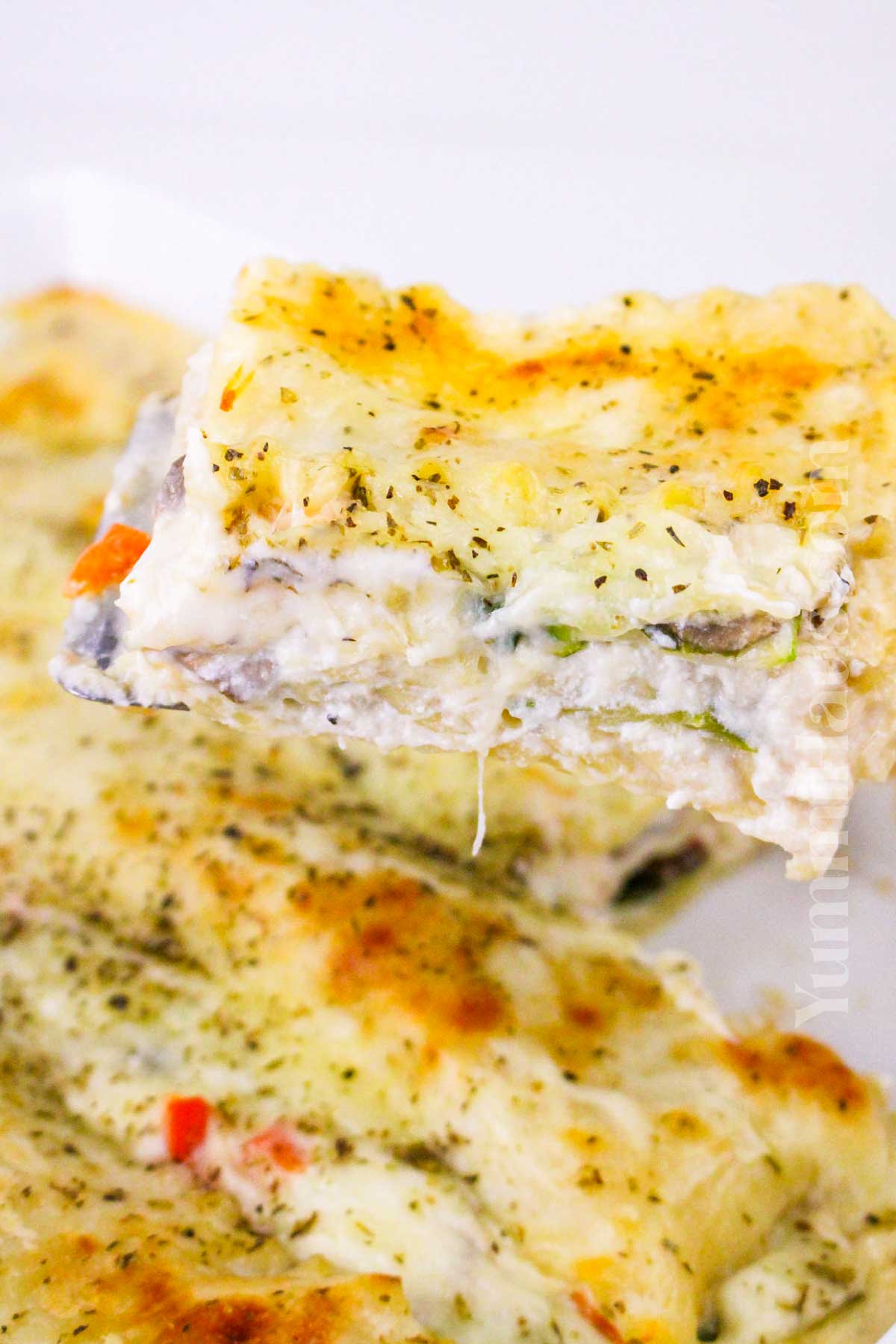
A good lasagna recipe will always have a rich cheesy white sauce though, so this part of the recipe remains the same.
- Gina’s Recipe Rundown:
- Why You’ll Love This Recipe
- Ingredients Notes
- Is White Sauce The Same As Bechamel Sauce?
- Kitchen Equipment
- How To Make Vegetable Lasagna With White Sauce
- Storage
- Substitutions & Variations
- Expert Tips To Make The Best Vegetable Lasagna In White Sauce
- Popular Questions
- How Do You Keep Vegetable Lasagna From Being Watery?
- Do You Put White Sauce On Every Layer Of Lasagna?
- What Vegetables Go With Lasagna?
- What Can I Add To My Lasagna To Make It Taste Better?
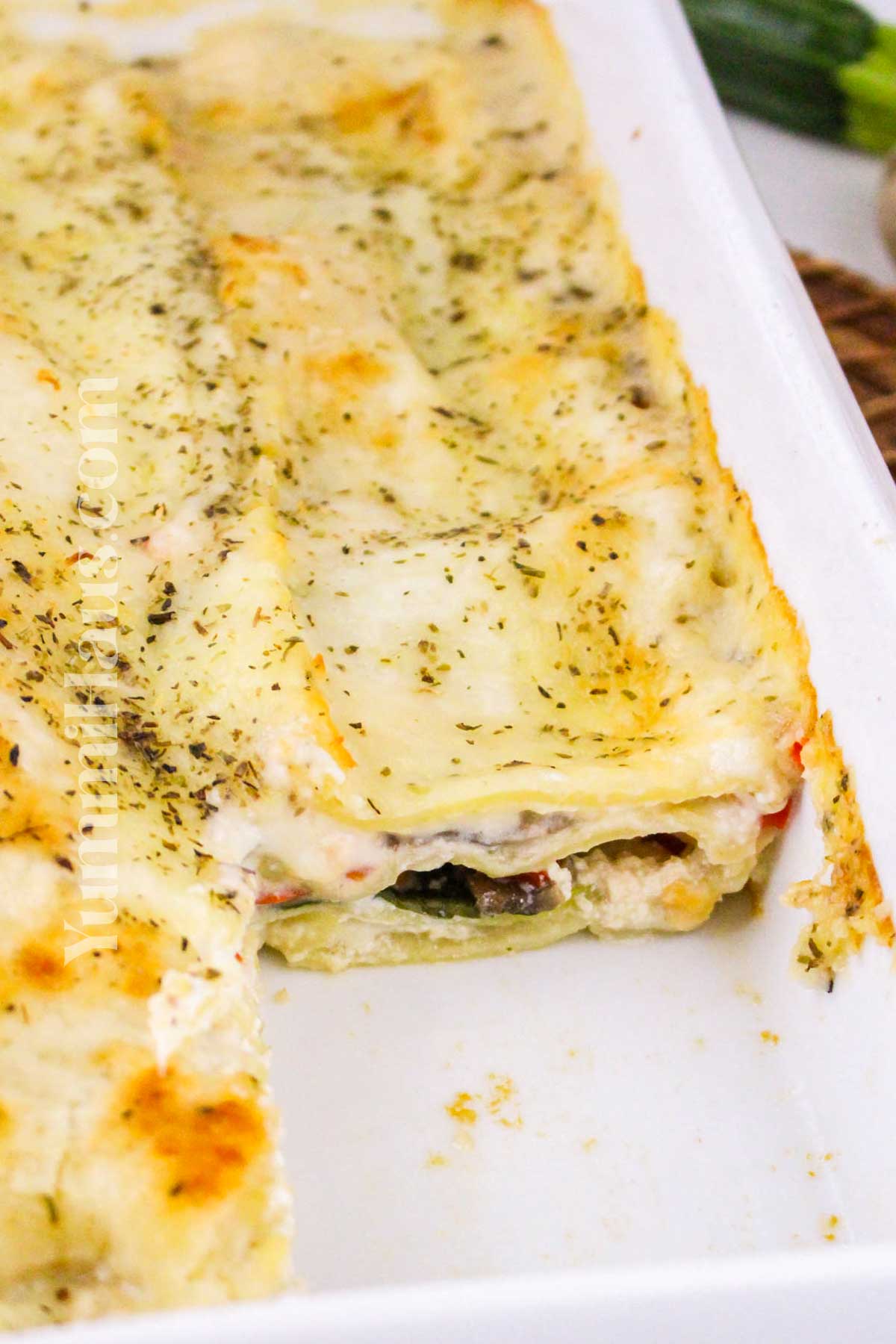
Why You’ll Love This Recipe
- Easy vegetable lasagna recipe for a quick vegetarian dinner or to impress your guests or little picky eaters.
- Absolutely delicious recipe. Think perfectly cooked vegetables, tender lasagna noodles, creamy white sauce, grated parmesan cheese... I’m already thinking about all the leftover lasagna I can eat the next day!
- Despite it being vegetarian lasagna, it is very hearty and filling.
- Healthy veggie-packed lasagna with tons of nutrients and gut-friendly fiber.
- Amazing dish for holiday tables.
Please, note this is not a vegan or gluten-free recipe.
Ingredients Notes
White Sauce
- Roux: butter + all-purpose flour
- Milk
- Garlic powder (or fresh garlic). I prefer using the powder vs minced garlic here to make a smoother sauce mixture without any lumps in it.
- Onion powder
- Salt and freshly ground black pepper to taste
- Parmesan cheese. I always recommend getting a block and making some freshly grated cheese at home. Store-bought shredded cheese mixture often contains anti-caking agents that will create clumps when the cheese melts in the sauce.
Lasagna
- Lasagna noodles. No-boil lasagna noodles or regular lasagna noodles, cooked according to package instructions.
- Zucchini
- Bell pepper
- Fresh spinach leaves
- Mushrooms
- Ricotta cheese. For the best flavors use whole milk ricotta cheese.
- Mozzarella cheese
- Italian seasoning
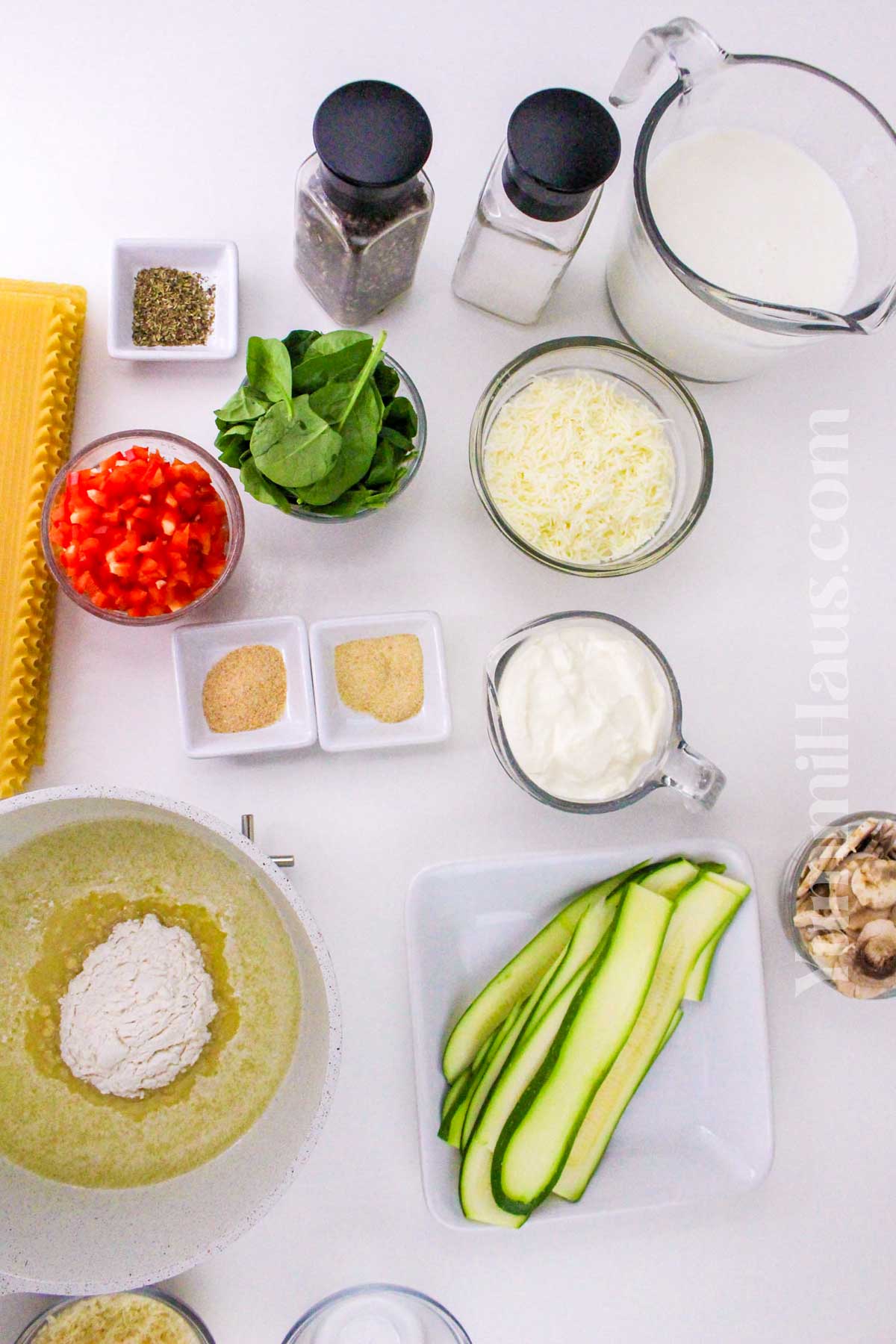
Is White Sauce The Same As Bechamel Sauce?
The white creamy sauce in this recipe is a twist on classic béchamel sauce. Bechamel sauce mixture often contains nutmeg and thyme, and no cheese.
While my cheesy sauce has some grated cheese in it, and no herbs.
They do have many ingredients and the cooking process in common though, both start with a roux.
Kitchen Equipment
- Saucepan
- 9×13″ baking dish or foil lasagna pan, should be at least 2.5” deep.
- Rubber spatula
- Aluminum foil to cover
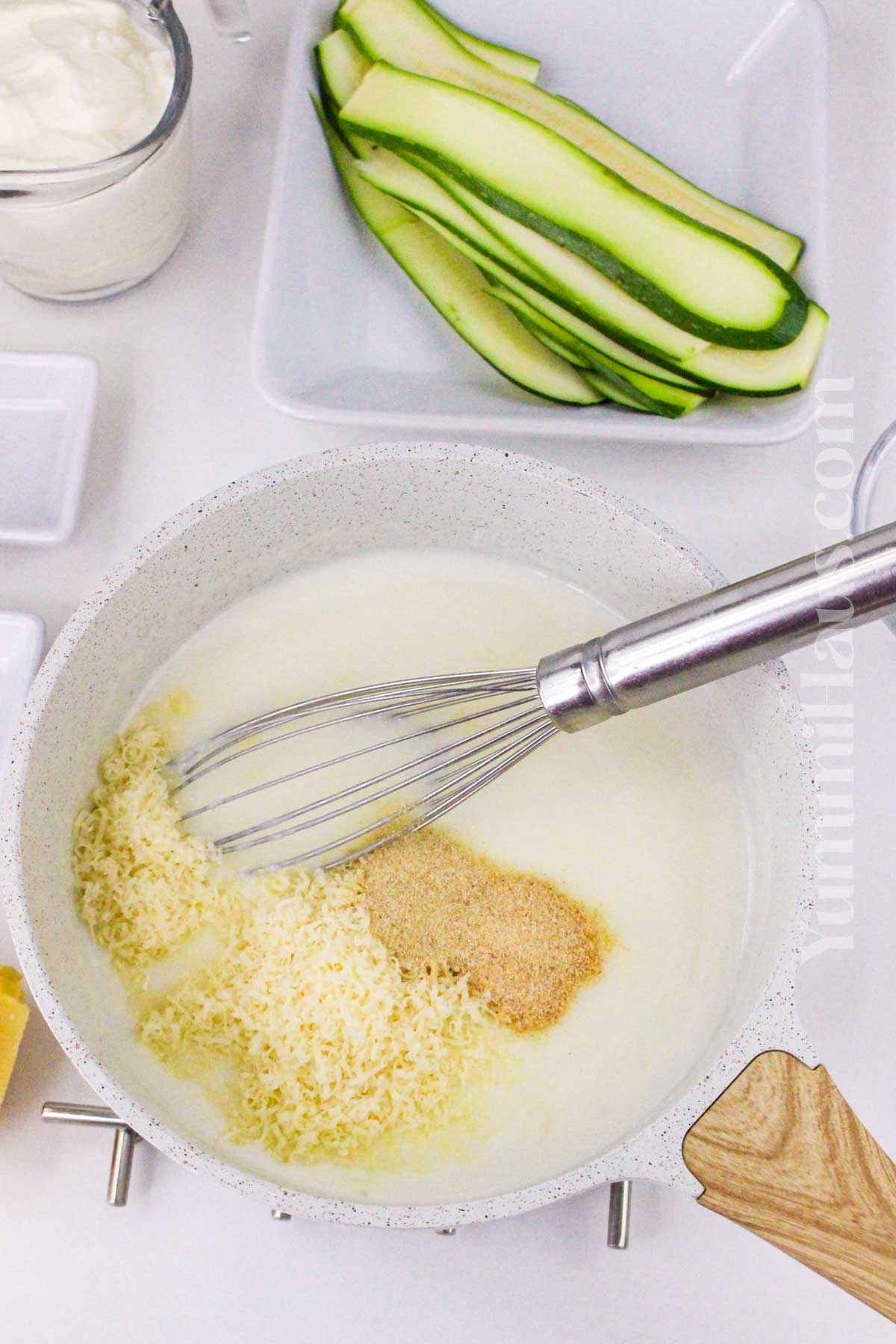
How To Make Vegetable Lasagna With White Sauce
1: Prepare The White Sauce
- Melt butter in a saucepan over medium heat.
- Stir in the flour to create a roux, cooking for about 1 minute, it should remain white-yellow.
- Whisk in the milk, continuing to stir until the sauce thickens.
- Stir in the garlic powder, onion powder, salt, pepper, and Parmesan cheese, stirring until smooth. Remove the sauce mixture from the heat.
*If you have regular lasagna noodles, boil them in salted water, drain, and lay them flat on a baking sheet.
2: Assemble Lasagna By Layers
- Preheat the oven to 375°F (190°C).
- Spray a 9×13 baking dish with cooking oil or olive oil.
- Spread a thin layer of the white sauce on the bottom of the prepared dish.
- Place 3 cooked lasagna noodles on top, followed by half of the ricotta cheese, half of the vegetables, and a third of the white sauce. Repeat the layers with the remaining noodles, ricotta, vegetables, and sauce. Usually, lasagna has 3-4 layers.
- To make it easier to spread the layers, mix cheese and spinach. Spread with a rubber spatula.
- Finish with the last layer of noodles and top with the remaining vegetable sauce and remaining mozzarella cheese and ricotta. You can also put 3 lasagna noodles as the top layer.
- Add the mozzarella cheese and Italian seasoning on top.
- You can assemble the veggie lasagna 24 hrs before baking it and store it in the fridge covered.
3: Bake
- Cover with foil and bake for 25 minutes.
- Remove the foil and bake for an additional 15-20 minutes, or until the cheese is bubbly and golden.
- Let the white vegetable lasagna rest for 10 minutes before serving to let it thicken and make it easier to slice.
Storage
Store leftover veggie lasagna in an airtight container in the fridge for 2-3 days. Reheat in the oven with baking dish covered at 350F or in the skillet.
- To freeze uncooked lasagna assemble all the layers in the foil pan or baking dish, wrap it tightly and freeze for 2-3 months. Cook frozen for an additional 20-30 minutes of original cook time or thaw overnight and bake as usual.
- To freeze cooked lasagna, let it cool, wrap it in a few layers of plastic wrap and foil, and freeze. If possible it is best to freeze individual portions. The sauce may become a bit grainy once thawed. Reheat for 15 minutes at 350F in the oven.
You can cook and store the sauce mixture separately. The white sauce will last in the fridge for 2-3 days and in the freezer for 2-3 months.
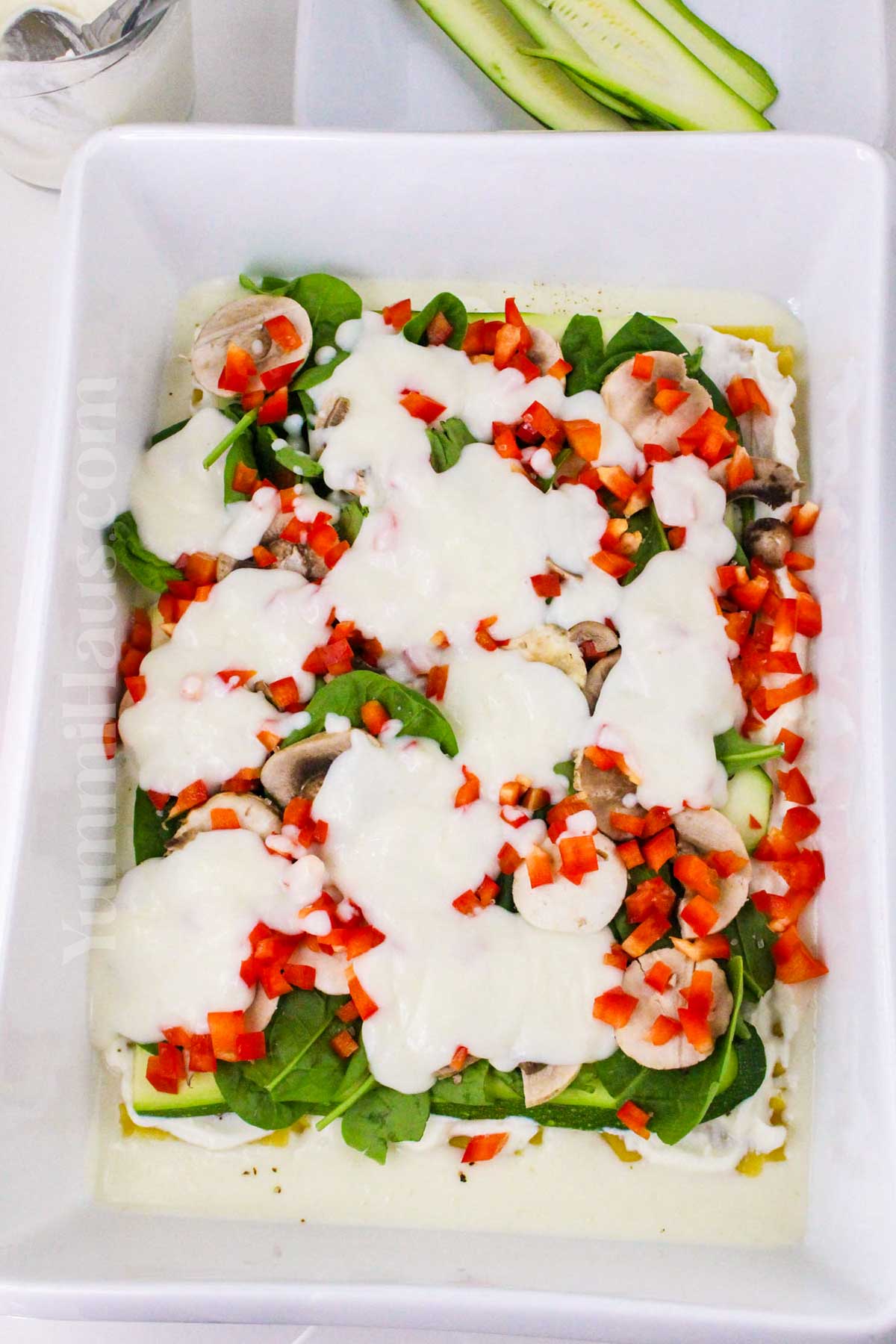
Substitutions & Variations
- Other veggies to add: yellow squash, kale, broccoli florets, bell peppers of different colors, carrots, eggplants, white beans, and peas.
- Cheese mixture options. You can use fontina cheese or cottage cheese for soft cheese, cheddar cheese, gouda, or Pepperjack cheese along with Parmesan cheese or Pecorino.
- White sauce can be replaced with tomato sauce. To enhance white sauce flavors, you can add chicken broth or vegetable broth, white wine, and heavy cream. You can always use store-bought Alfredo sauce too and simply make it better with seasoning.
- Make it spicy. Red pepper flakes, cayenne pepper, or regular hot sauce will add a nice hot kick.
- Non-vegetarian lasagna. Simply add some shredded chicken, Italian sausage, or even ravioli.
- Add more texture. Sprinkle some crushed cracked as topping. They will brown nicely and add a bite. Simply mix melted butter and crumbs, and top the lasagne with the mixture.
Expert Tips To Make The Best Vegetable Lasagna In White Sauce
You can pre-cook all the veggies in some olive oil with onions and minced garlic before adding them to the lasagna.
The only worry with no-boil noodles is that they rely on the juices of all the veggies and the sauce to get cooked in the oven.
If you don’t add enough sauce in between layers or use the pre-cooked drained vegetable mixture, the noodles can have not enough liquid to cook evenly.
However, as many times as I cooked this dish, I’ve never had dry noodles.
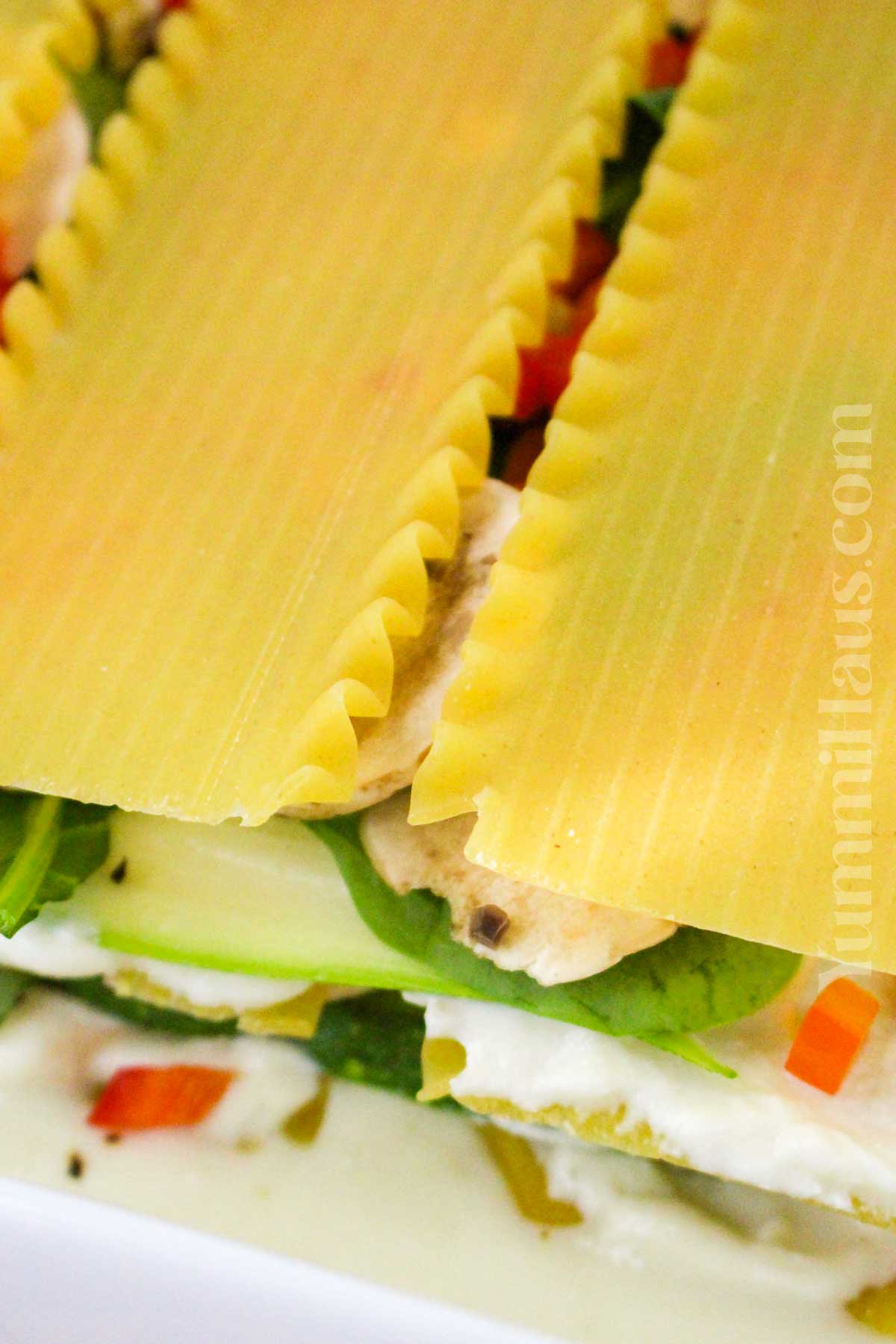
Popular Questions
How Do You Keep Vegetable Lasagna From Being Watery?
If you use cooked mushrooms and veggies you need to drain them well and remove all the excess liquid from the cheese mixture to make sure you won’t have soggy lasagna with watery sauce. Eggplants, zucchini, bell peppers, and frozen veggies usually have the most liquid.
Once the lasagna is baked, always let it rest to allow all the juices to soak up into the lasagna noodles and for the sauce to thicken.
Do You Put White Sauce On Every Layer Of Lasagna?
Yes, lasagna is best when it is saucy and not dry. So we need to divide the filling and sauce mixture between all the layers evenly, plus, you should start and finish assembling a lasagna with white sauce.
What Vegetables Go With Lasagna?
Veggie side dishes to go with lasagna are endless. Lasagna pairs well with sauteed green beans, broccoli, zucchini, asparagus, spinach, cooked mushrooms, and pretty much any veggies that are good for sauteeing or roasting.
What Can I Add To My Lasagna To Make It Taste Better?
Seasonings like fennel seeds, herbs, nutmeg, and thyme add a ton of flavor to lasagna sauce.
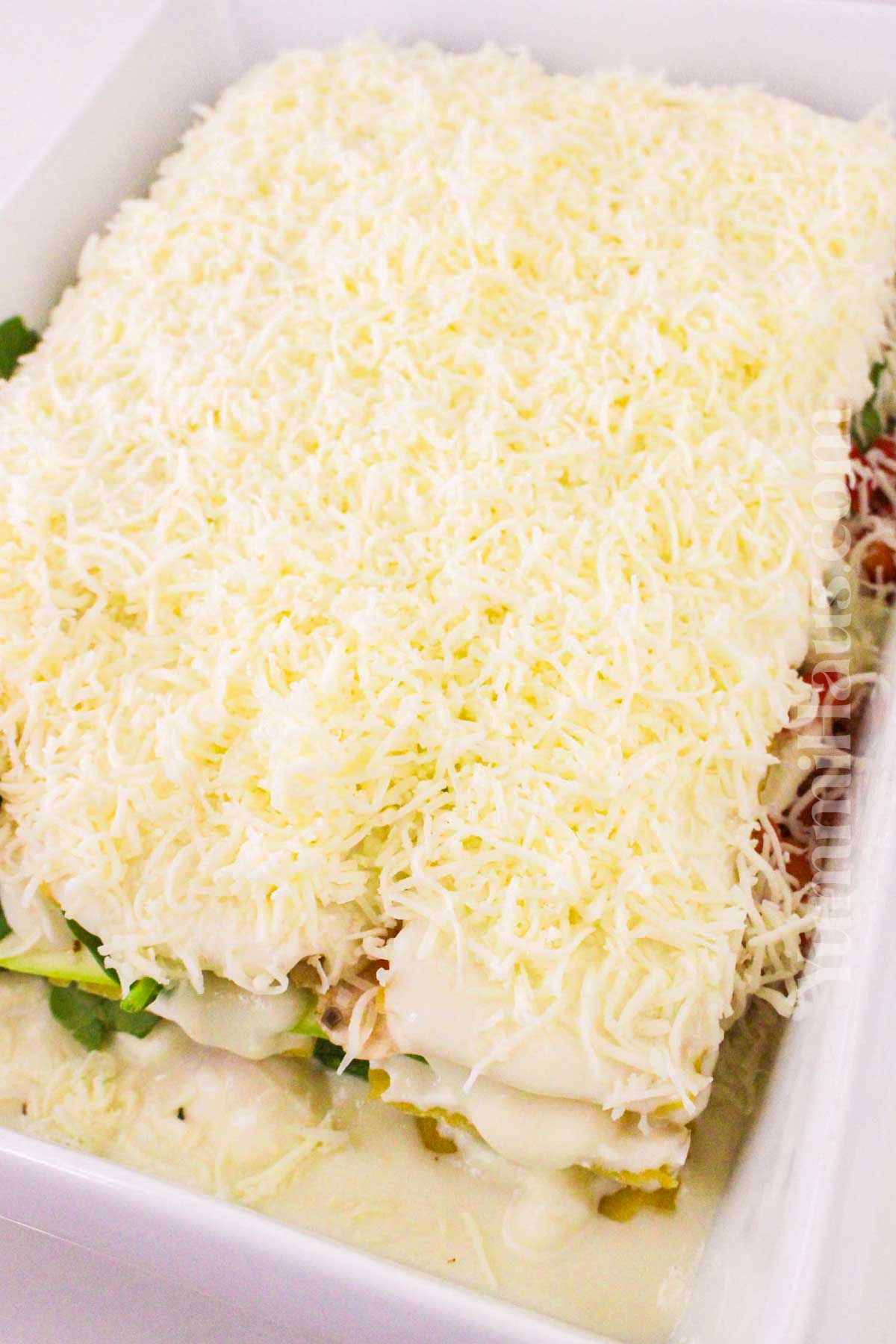
If you love this quick dinner recipe, you’re going to love these other quick meals too. Please click each link below to find the easy, printable recipe!
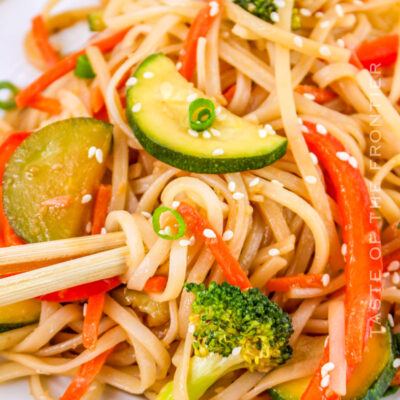
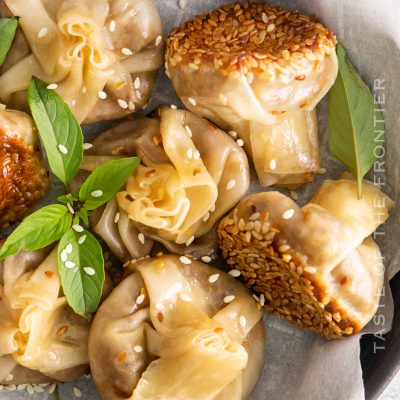
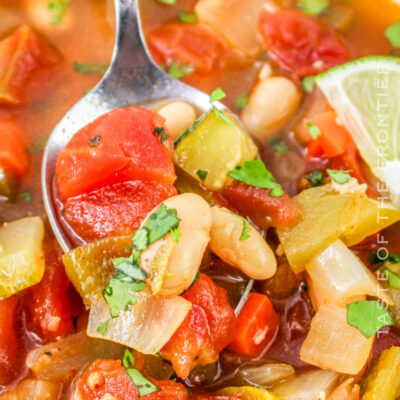
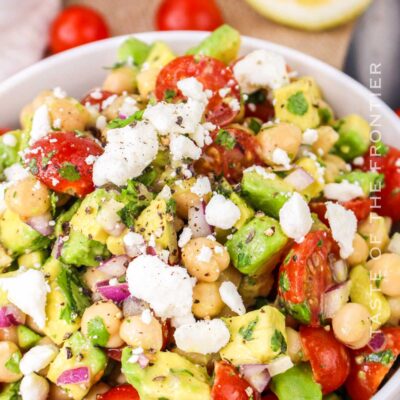
More Great Veggie Recipes
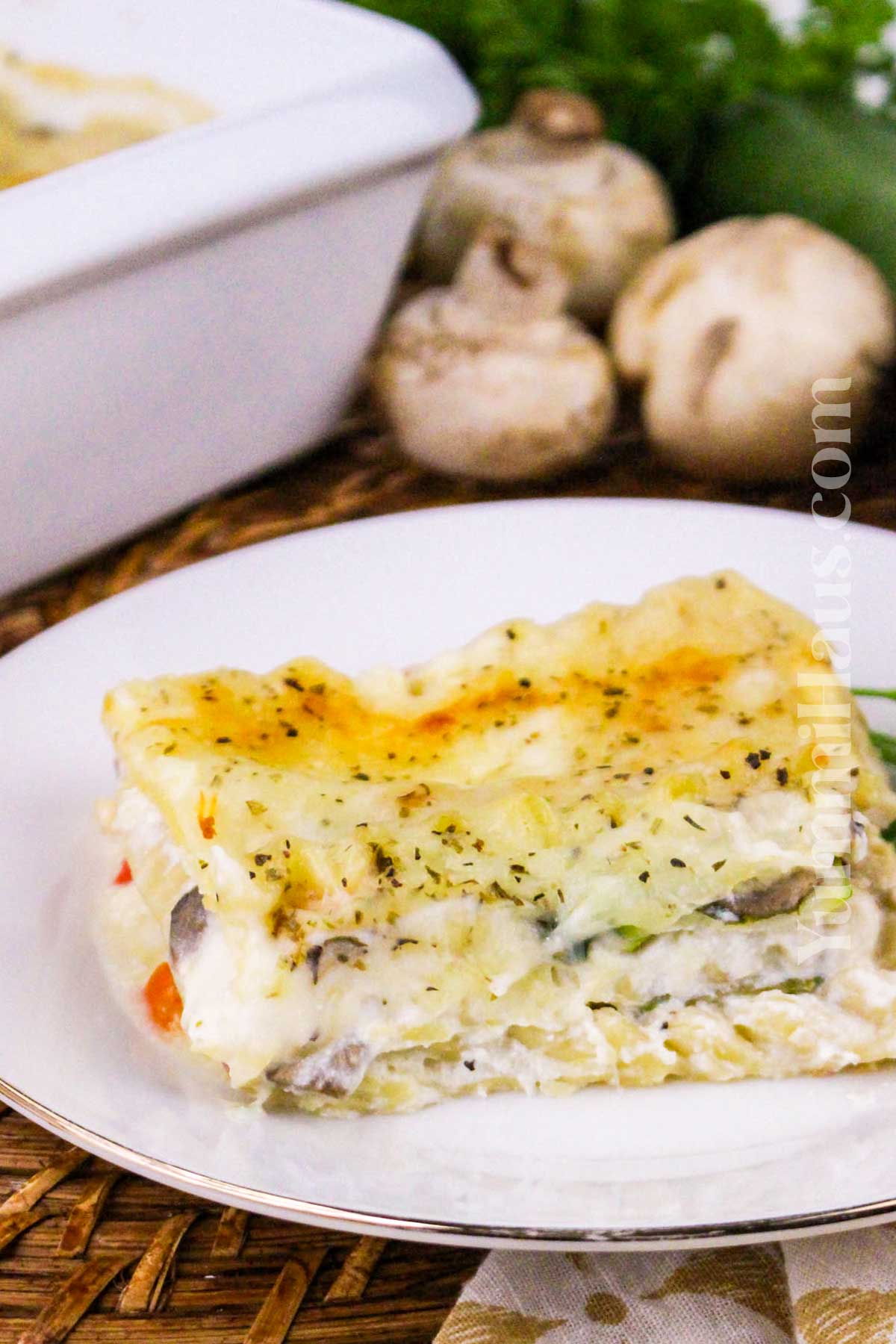
CONNECT WITH YUMMI HAUS!
Be sure to follow me on my social media, so you never miss a post!
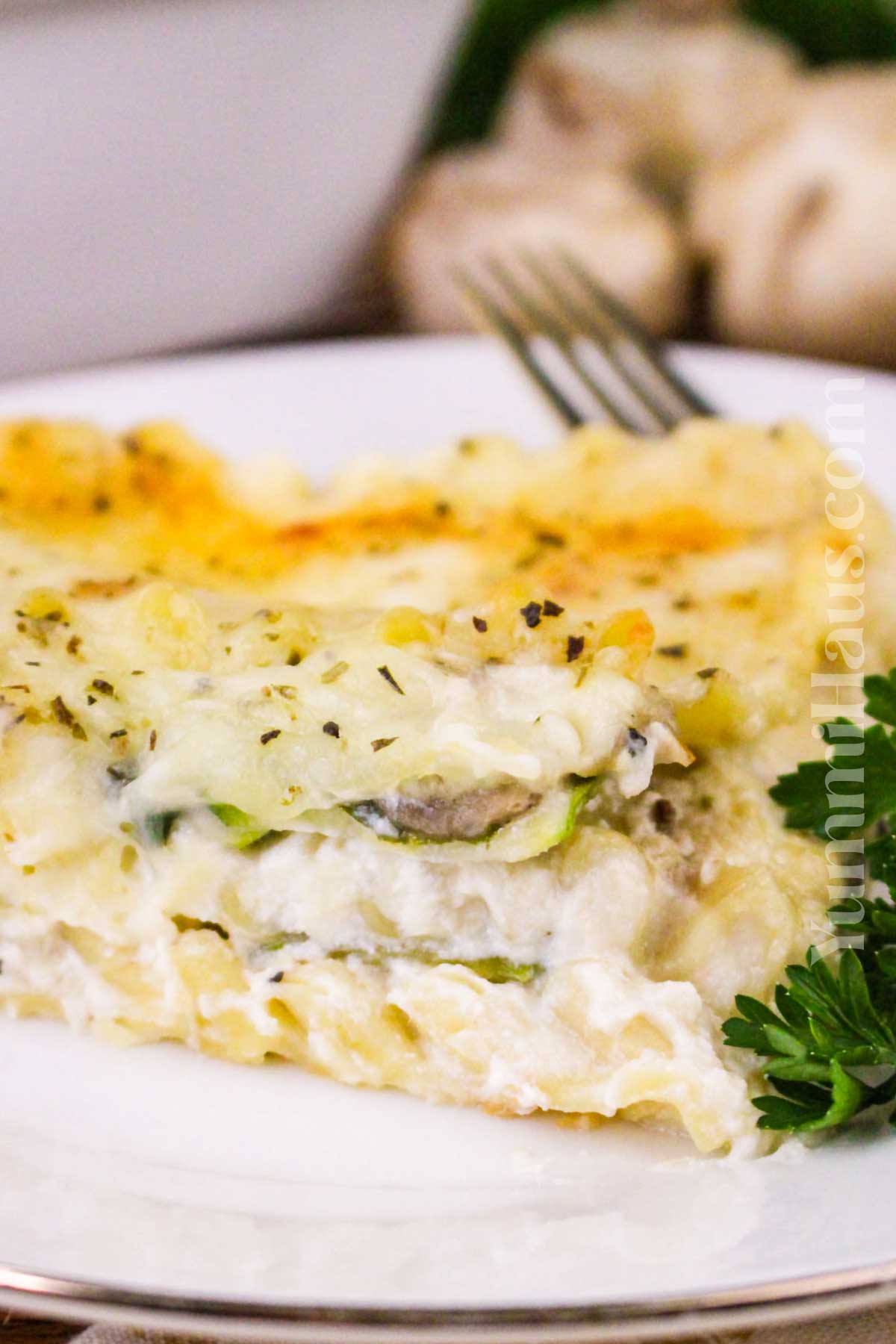
Vegetable Lasagna in White Sauce
Ingredients
White Sauce
- 4 tablespoons butter
- ¼ cup all-purpose flour
- 3 cups milk
- 1 teaspoon garlic powder
- 1 teaspoon onion powder
- salt and pepper to taste
- ½ cup Parmesan cheese – grated
Lasagna
- 9 lasagna noodles no-boil variety or cooked according to package instructions
- 1 zucchini thinly sliced – medium
- 1 bell pepper diced – medium
- 1 cup spinach leaves
- 1 cup mushrooms sliced
- 1 cup ricotta cheese
- 1 cup mozzarella cheese – shredded
- 1 teaspoon Italian seasoning
Instructions
- Melt the butter in a saucepan over medium heat.
- Stir in the flour to create a roux, cooking for about 1 minute.
- Whisk in the milk, continuing to stir until the sauce thickens.
- Stir in the garlic powder, onion powder, salt, pepper, and Parmesan cheese, stirring until smooth. Remove from heat.
- Preheat the oven to 375°F (190°C).
- Spray a 9×13 baking dish with cooking oil.
- Spread a thin layer of the white sauce in the bottom of the prepared dish.
- Place 3 lasagna noodles on top, followed by half of the ricotta cheese, half of the vegetables, and a third of the white sauce. Repeat the layers with the remaining noodles, ricotta, vegetables, and sauce.
- Finish with the last layer of noodles and top with the remaining white sauce.
- Add the mozzarella cheese and Italian seasoning on top.
- Cover with foil and bake for 25 minutes.
- Remove the foil and bake for an additional 15-20 minutes, or until the cheese is bubbly and golden.
- Let rest for 10 minutes before serving.
Nutrition
Nutritional information for the recipe is provided as a courtesy and is approximate. Please double-check with your own dietary calculator for the best accuracy. We at Yummi Haus cannot guarantee the accuracy of the nutritional information given for any recipe on this site.


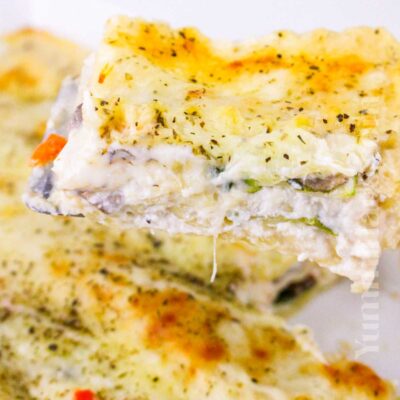






Share Your Thoughts